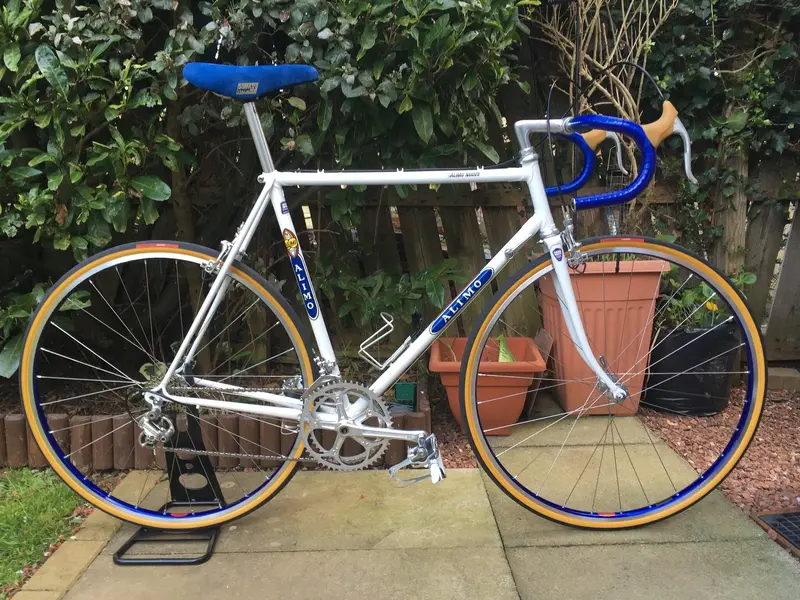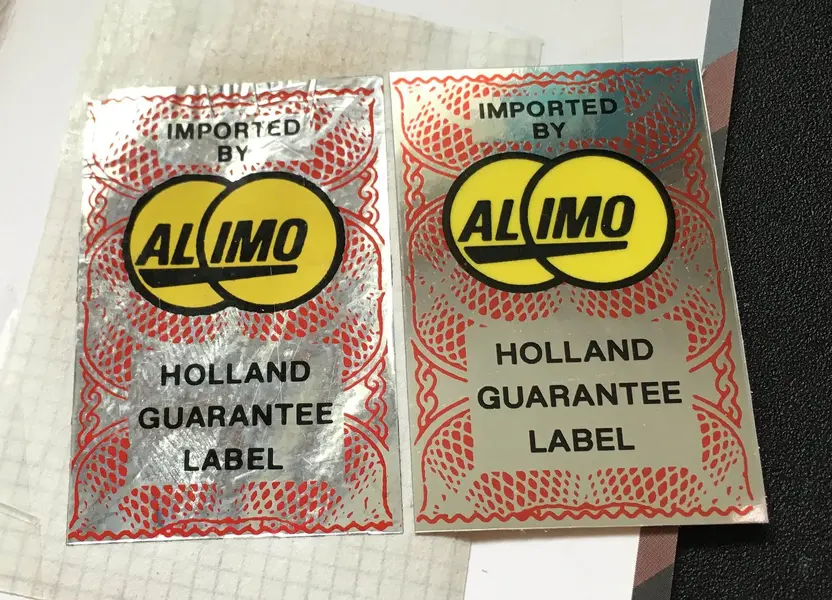You are using an out of date browser. It may not display this or other websites correctly.
You should upgrade or use an alternative browser.
You should upgrade or use an alternative browser.
Alimo - Dutch Benotto sub-brand (70-80s)
- Thread starter SuperSid
- Start date
SuperSid
Old School Hero
Here is a work in progress pic, I had a few compatibility issues with the build.Thank you for the eleborate update. The frame set looks great. Well done!
Looking forward to the build. Less than 21lbs will be a very decent result, IME.
- The frame's gear shifter bosses are a different design to the usual square kind of which the Shimano Dura Ace SL-7200 levers are designed for, the lock nut screw hole is also smaller in diameter. I'm re-using the parts from the original Shimano Altus levers and will 3D print an adapter washer in nylon. I could do with finding a compatible screw, the originals are a bit pitted, I measured a thread diameter of 4.4 mm with a thread length of 8 mm.
- I was planning to fit a modern titanium bottom bracket however, my assumption that it was a standard BSA 68 BB was incorrect, I should have measured. I had to refit the original (very heavy) BB, thankfully it runs incredibly smoothly so not too disappointed.
- I was intending to fit the original handlebars from my 1987 Peugeot Perthus but the Cinelli 1R won't clamp the French bars 25.4 mm clamping diameter. I just ordered some used 3TTT Superleggero bars - which I wanted anyway from Ebay. The 60 gram weight reduction should offset the lack of bottom bracket weight saving.

non-fixie
Senior Retro Guru
I'll readily admit to not being the biggest fan of colour matching everything on vintage racing machines, but in this particular case it actually works quite well. "Thoughtful execution" seems to be the key to success here. I like it. 
WRT the frame's origin, I've been browsing back through this thread, and many things point it having come from Belgium:
- it was common practice in those days in Holland to import "blank frames" from Belgium
- the lack of a serial number was part of that concept
- the Belgians were early adopters in Europe of Japanese products, such as Shimano parts and Ishiwata tubing
- the look of the seat cluster, especially the seat stay tops, jibes with many other Belgian frames I've seen
- the mix-n-match approach was always popular in the low countries
WRT the frame's origin, I've been browsing back through this thread, and many things point it having come from Belgium:
- it was common practice in those days in Holland to import "blank frames" from Belgium
- the lack of a serial number was part of that concept
- the Belgians were early adopters in Europe of Japanese products, such as Shimano parts and Ishiwata tubing
- the look of the seat cluster, especially the seat stay tops, jibes with many other Belgian frames I've seen
- the mix-n-match approach was always popular in the low countries
SuperSid
Old School Hero
I think the trick is to have mostly neutral colours with just a few flashes of colour strategically placed. I Photoshopped a load of various colour schemes but the blue, white and gold versions looked the most tasteful and retro. Another one that looked good was black instead of blue but it had a more modern appearance.I'll readily admit to not being the biggest fan of colour matching everything on vintage racing machines, but in this particular case it actually works quite well. "Thoughtful execution" seems to be the key to success here. I like it.
WRT the frame's origin, I've been browsing back through this thread, and many things point it having come from Belgium:
- it was common practice in those days in Holland to import "blank frames" from Belgium
- the lack of a serial number was part of that concept
- the Belgians were early adopters in Europe of Japanese products, such as Shimano parts and Ishiwata tubing
- the look of the seat cluster, especially the seat stay tops, jibes with many other Belgian frames I've seen
- the mix-n-match approach was always popular in the low countries
Interesting what you say about the Belgian influence and origins.
I'd like to speak with someone who worked at Alimo in the 70s, what you say makes perfect sense. The early Alimos with the front light support on the wrong side for Europe, must be Japanese, but it remains a mystery who built them.
I know that my frameset is Italian built for sure, my bottom bracket size is 70 x 119 mm (36 x 24T), it has Campagnolo and Piazza dropouts and looks like a cut price Benotto.
non-fixie
Senior Retro Guru
Interesting! 70mm BB shells were not uncommon in Belgium, but most had BSC threading, AFIK. Changing that to Italian, in order to create something that would resemble an Italian product wouldn't have been much of a challenge, though.
And in those days. the bulk of the production of the bigger Belgian builders, such as Martens en Vaneenooghe seems to have been for others to re-brand.
And in those days. the bulk of the production of the bigger Belgian builders, such as Martens en Vaneenooghe seems to have been for others to re-brand.
SuperSid
Old School Hero

Just a few tweaks left but my Alimo is finished and rideable.
Riding feels super smooth in every way. The wheels are my first self built set, I was concerned that they might collapse but they actually feel solid, the 28mm cotton tyres will be a game changer for me, such a plush comfortable ride.
The transmission is working flawlessly but the new pedals seem like they are packed with grease so don't spin freely yet. The 3TTT Superleggero handle bars aren't as attractive as the Philippe bars with their tighter drop bends. but the hoods are positioned significantly higher which makes the riding position very comfortable.
Things left to do (pending delivery):
- Replace pitted M4.5 shifter bolts with new Dia Compe ones.
- Replace rounded Cinelli 1R bar clamp bolt.
- Fit Omniracer Titanium bottom bracket
On my luggage scales which aren't particularly accurate or consistent - I'd say within +/-100 grams accurate, it currently weighs 9.45 kg. The titanium BB will drop another 140g. I'm quite pleased with that, this weight is comparable with pro bikes and range toppers from the early 80s fitted with tubs.
Last edited:
SuperSid
Old School Hero
Thanks to @Prum who carefully peeled the original sticker off intact, I was able to reproduce the chrome "Imported by Alimo" label and get a batch digitally printed.
Here is a comparison of the original and reproduction, side by side and close up. You'd have to see two stickers in this situation to notice any differences but fitted to a bike frame I don't think you'll be able to tell that it's a repro.

Here is a comparison of the original and reproduction, side by side and close up. You'd have to see two stickers in this situation to notice any differences but fitted to a bike frame I don't think you'll be able to tell that it's a repro.

Similar threads
- Replies
- 18
- Views
- 6K
- Replies
- 7
- Views
- 2K
- Replies
- 1
- Views
- 2K